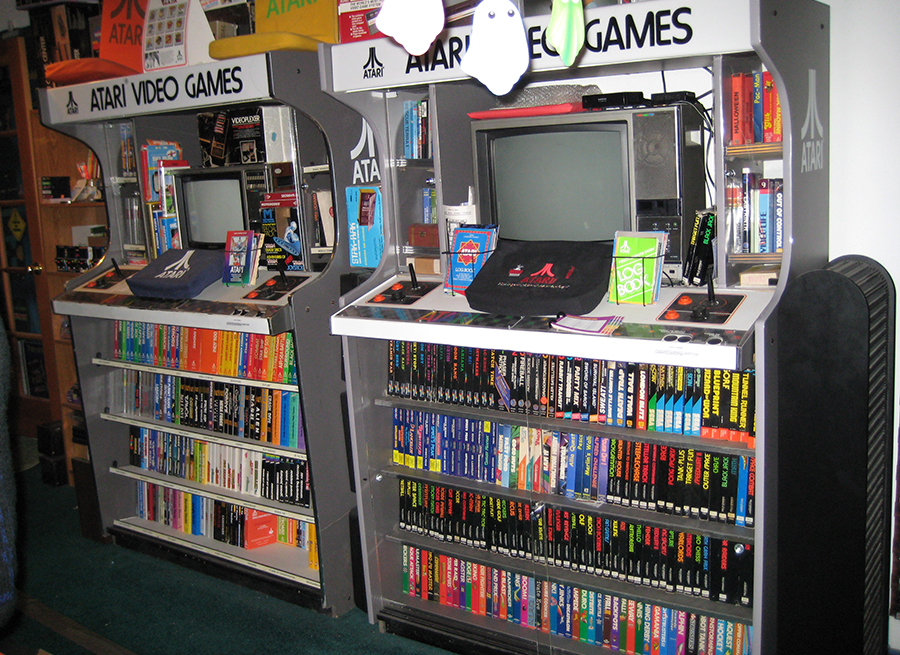"Unlike modern games, you can play these in just 15 minutes,” says Weis, whose collection obsession led him to launch the annual Portland Retro Gaming Expo, which typically draws some 12,000 gamers and dealers. “I grew up playing all the games with friends and family. For many people, these games remind them of their younger days and they want to share them with their kids."
In the Dallas suburb of Frisco, Texas, visitors can relive those younger days — or learn about the games of yesteryear — at the National Videogame Museum. The facility houses a timeline of video game consoles, a gallery of ‘80s arcade games and other exhibits that, before the pandemic, drew about 60,000 enthusiasts per year.
“I grew up playing all the games with friends and family. For many people, these games remind them of their younger days and they want to share them with their kids."
"Our collection is more than just games. It's oral histories with the developers or the people who made them. It's backups of the software. It's archiving and preservation of actual documents, press kits and stuff like that,” says John Hardie, one of the museum's founders. “There are items out there — games and systems — where the only knowledge you had that it ever existed might be an old press kit."
ArcadeImages / Alamy Stock Photo
Innovative games and the people who made them
Creators of Doom John Romero, 53 and Wizardy 8 Brenda Romero, 54
John: We spent the year of 1993 making Doom. We knew it didn’t exist anywhere. Doom changed the industry, including the rules of multiplayer games and allowing the game to be modified by the community — to change music, textures, you name it. Brenda: Wizardry was to Japan what Doom was to the U.S. It paved the way for role-playing games like Final Fantasy, which took their inspiration from Wizardry.
Creator of Pong, Allan Alcorn, 73
I was a 24-year-old engineer. Nolan Bushnell [founder of Atari] wanted to give me practice. It was the very simplest video game one could ever think of. I made it as playable and as fun as I could. When we released it, very much to my surprise, it became a hit right away. I’m blessed by having the opportunity to create something that changed the world a little bit, you know?
Creator of Centipede Dona Bailey, 65
My supervisor gave me a notebook with game ideas. There was a line about shooting a multi-segmented insect. I’ve always been weird about bugs, and it sounded like a good idea — a great afternoon of, you know, killing insects. The game is so me. It was whimsical. It was quirky. I put a lot of time into trying to make it look good.
Even developers of modern games have gotten in on the nostalgia craze. Skateboarding legend Tony Hawk, 52, recently brought back his original Pro Skater video game, 20 years after its initial release for the Sony PlayStation console. But here's the twist: Although the new game (now playable on PlayStation 4 and Xbox One) features the original skater characters — Hawk and other pros — they have aged by two decades.
"I felt so lucky and proud that almost all of the original skaters in our roster are still around and actively skating, so let's highlight that in terms of doing it their current age,” Hawk says. “If they were stuck in this time capsule of being in their 20s or 30s, I don't think it would do them justice."
While Hawk's game is nostalgia in the form of a update — a sort of “deluxe edition” of an old favorite — the opposite dynamic also exists. Some people are creating new games for consoles that haven't been produced in decades. It would be as if a musician wanted his new album pressed on phonograph wax cylinders.
So-called “homebrewers” program new games on the simple code of old systems — Atari 2600 is particularly popular — and sell them online to other enthusiasts.
One older developer even got drawn back into the field. Decades ago, Dan Kitchen, 59, developed games for the Atari 2600, including the 1982 home version of arcade classic Donkey Kong (with his older brother Garry), and then went on to a fruitful career progamming games for the Commodore 64 personal computers, various Nintendo systems and other platforms.
Kitchen even was involved with a computer figure-skating game featuring Oympian Kristi Yamaguchi in the 1990s, one of the first games to incorporate motion-capture video into its graphics. So it was a back-to-basics labor of love that caused him to return to an old game he never quite finished while working for publisher Activision in 1983.






































































More From AARP
Why We Like Video Games (Maybe We're Control Freaks)
From phone puzzles to fantasy adventures, here's why digital gaming is devouring the worldRetro Video Games Give Players a Flashback to Their Youth
Museums, gaming expos and rereleases of classics offer nostalgia